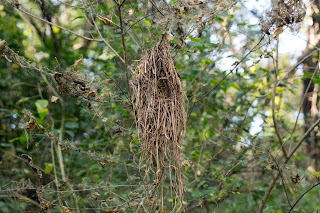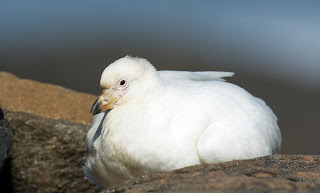 |
| Baobab (Adansonia digitata) - the upside-down tree |
Most
outdoorsmen speak kindly of the piece of earth they call home. They wouldn't be
outdoorsmen, by rights
, if they thought otherwise.
There are also, as we know, the
charlatans of the woods who speak volumes of God & Country in an act of
one-upmanship for anyone naive enough to fall for the rhetoric. It becomes an exercise of futility, therefore, to lay claim to '
The most beautiful country on earth' without appearing boorish or brash. Even so, you would be hard-pressed, by anyone's definition, to find a more diversely spectacular country anywhere. South Africa is truly blessed.
In our southern hemisphere winter, from late May to August, the weather, by northern hemisphere standards, is mild enough to spend a pleasant day outdoors, most days. There are, however, the odd occasions when the southern ocean winds drive even the hardened few inside. Rather than endure a smoke-filled room and the subsequent headache after a red or two,
outdoorsmen head north-east; far north-east to the Tropic of Capricorn where the winter sun is always warm.
 |
| Early-morning mists over the Albasini dam near Elim (Limpopo) |
Home to a people of character and a lasting cultural identity, colloquial '
Venda' is quintessentially the '
Garden of South Africa' for which the Limpopo province is known. It's a region of contrasts, none more surreal than around the town of Louis Trichardt. Here bushveld, inselbergs, mountains, indigenous forests, unclaimed wilderness and farm mosaics can be safely crisscrossed in less time than it takes to say
Entabeni Forest which is where we were headed.
 |
| Crested Guineafowl - Elvis would smile quietly to hisself.. |
This afromontane forest in the Eastern Soutpansberg mountains is home to Black-fronted Bush-Shrike, Bat Hawk & Scaly-throated Honeyguide; all of which we needed for our
800 Challenge.
Centrally-based at Shiluvari Lodge (Wild Pear) on the Albasini Dam, near Louis Trichardt, we spent a quiet Saturday at Kruger's Pafuri for one or two localised specials ahead of Sunday's more deliberate assault on the afromontane forests for the less-conspicuous birds on the
Venda itinerary.
For the
Venda leg we employed the services of Samson, a local guide and someone we'd met years before when both he & '
we' were new to the birding fraternity.
 |
| Dark Chanting Goshawk - a bird we later banded. |
Samson is quietly spoken but knows the area well. We were after one or two specific birds rather than the general smorgasbord the area is renowned for.
 |
| Diversity - enthralling |
 |
| Kliphuis - Entabeni Forest, shrouded in mist |
Our attack on the slopes, so to speak, was somewhat different and timing, therefore, became more important than would otherwise have been the case. By way of example we spent six hours looking for Blue-spotted Wood Dove at Royal Macadamia's Muirhead dam on the Levubu river. Our first attempt at finding the bird failed. It was only much later on a revisit to the same spot that we were fortunate to find a single bird feeding on crushed macadamia nuts.
Adjusting to our tempo, out the gates, was a shock for Samson but like most professionals he soon caught on. That said, the 6:30 am start at Entabeni was a gross miscalculation of the elements and a mistake. A soup of heavy winter mist blanketed the forest which made our birding efforts, however well-meaning, redundant at best. These are the mistakes we learn from.
Returning to the mist-free altitudes at the foot of the forest we notched up Bat Hawk & a pair of Scaly-throated Honeyguide, a bird neither Alisha nor I had photographed before. Even though photography in both the overcast conditions and in the shaded canopies proved difficult, we both managed record shots of the birds. The photos are iffy, at best, but treasured, along with many others, for their value rather than the quality of the image.
 |
| Scaly-throated Honeyguide - iffy but treasured. |
Later that morning our efforts at Muirhead Dam, on the Royal Macadamia estates, for Blue-spotted Wood Dove, proved a frustrating exercise. By mid-afternoon we were forced to concede defeat and head-off to Roodewal Nature Reserve, some 15 km further west, for African Broadbill. The broadbill is an elusive, nondescript little devil more difficult to find than an honest lister. Whilst the walk was less demanding than initially described we'll remember our afternoon for events unrelated to either the Broadbill, which we never found, or its nest, which we did find.
 |
| Roodewal Nature Reserve |
 |
| The untidy nest of the African Broadbill |
What unraveled that afternoon, in those forests, will stay with me forever for a number of reasons but perhaps more so for the initial shock & subsequent humour and later the appreciation of what we truly are, just a chink in the natural order of things.
 |
| African Rock Python - 485cm of muscle |
This part of the story has two chapters; the first unfolded late Sunday & the second early next morning on Monday.
We weren't about to follow defeat at Muirhead with another at Roodewal. As a result we persevered in areas of Roodewal where few people ever venture. This part of the forest, in the late afternoon shade, ensured that visibility was down to less than 10 paces.. Leopard sign was everywhere & fresh scats littered the pathways which usually makes these things 'fun'..
The cathedral-like silence of the forest generally reciprocates the same response from most people. Not immune from the forest charms we walked on in trance-like reverence. An unholy, other-worldly, goat-like bleat and a later measured world record leap skywards into the overhanging branches wrenched us back from our world of reverie! Sometime later, after the echoes had died down, a more coherent Samson returned to terra-firma where he pointed out a rather substantial snake basking in an open glade alongside the stream we had been following. Unappreciative of Samson's unlikely soprano and less impressed than we were by his less-than-perfectly choreographed leap into the tree-tops, our snake preferred the cool waters of the nearby stream and departed for places other...
We accepted the
pressing advice of our guide to abandon any further attempts for Broadbill, its absence a seasonal aberration apparently, in favour of the more readily obvious Blue-spotted Wood Dove back at Muirhead Dam.. We found the dove!
We returned, without our songstress athlete* (*
Samson laughed later almost as much as we did then. Who can blame him for his immediate reaction?), to the same spot early next morning in the hope of a photo or two. By luck rather than by design we relocated the python nearby and whilst Alisha made breakfast
back-at-the-car I snapped off a few shots. Fortunately the snake was in the initial phases of shedding its skin which, whilst not improving its sense of humour much, usually makes it less inclined to flee. For an hour she tolerated my unsolicited advances. Invisible lines were drawn in the sand which neither she nor I crossed and that's how it should always be, for her safety and ours. The attached photo I took with a 100 mm macro lens, testimony to her current condition and perhaps too a tolerance we don't usually associate with these gentle giants.
A short while later & after she had left via the same stream she had used the afternoon before, I paced out her length, as written in the sands. She measured an incredible 4.85 meters, easily powerful enough to send me to the great aviary in the sky, an eventuality I prefer to avoid at the moment. What a lady!
As an addendum to this story, whilst en route to the python and on foot, Alisha & I were 'thrilled' by the antics of a large male leopard which joined us for our morning stroll and within arm's length. My leopardese is a bit rusty but, at a guess, from its curses and short rushes through the chest-high grass we weren't his type..
 |
| Tropic of Capricorn - early morning |
Sunrises, sunsets, a dash of hysterical laughter, 'difficult' birds and the occasional unsolicited charms of our co-conspirators in the bush make Limpopo province generally and
Venda specifically, our winter home away from home.


























